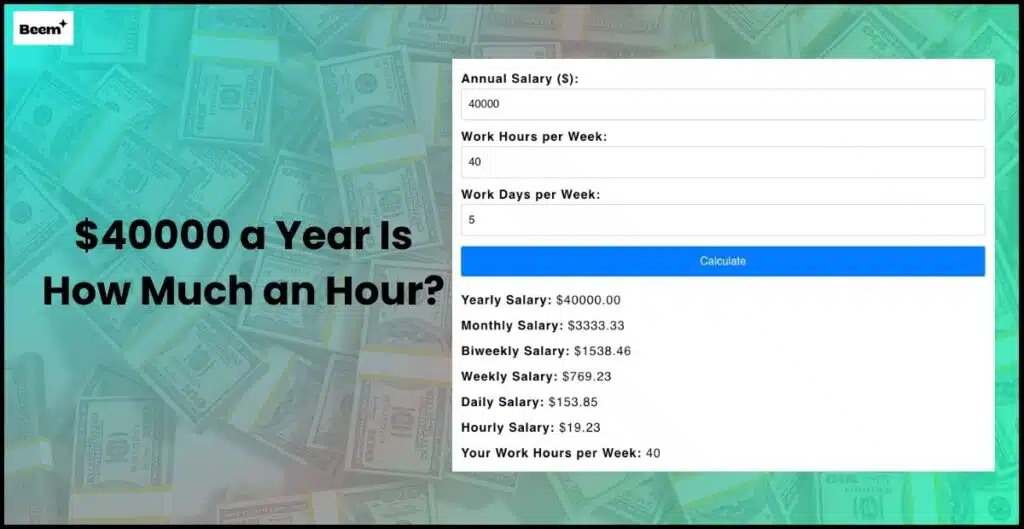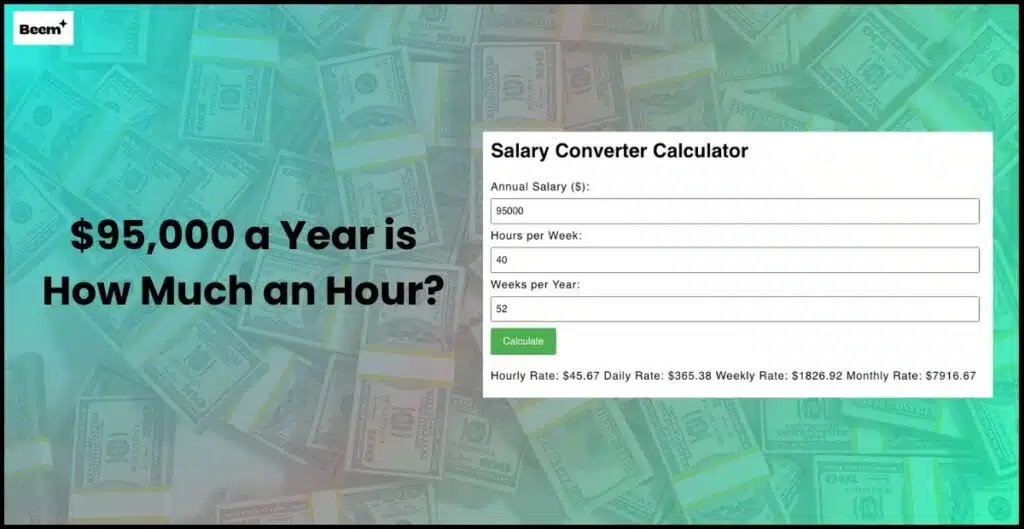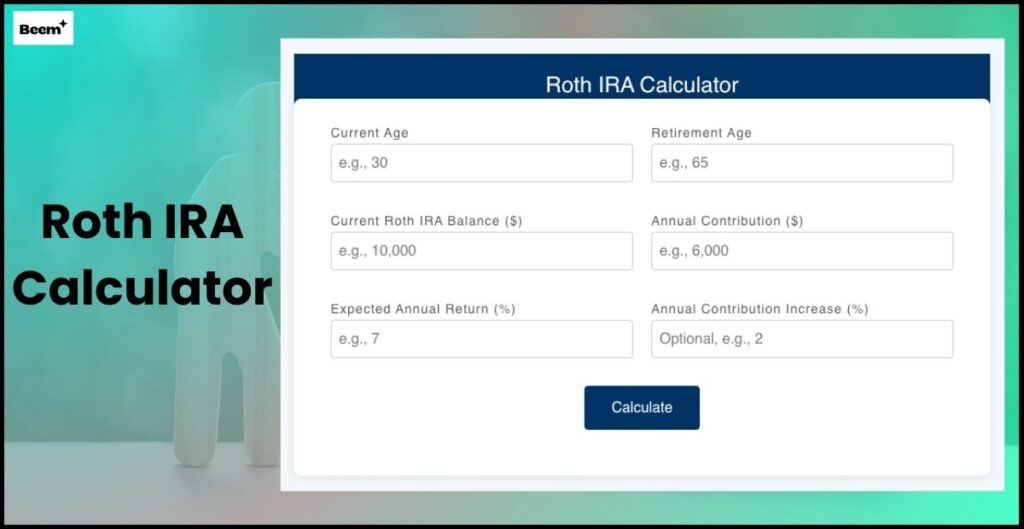When considering a new job offer or evaluating your current salary, you might ask yourself, “$60,000 a year is how much an hour?” The answer isn’t just a number—it’s a gateway to understanding your true earnings potential.
Converting your annual salary into an hourly wage can help you compare job offers, understand the value of your time, and plan your finances accordingly.
In this article, we’ll explore in detail how a $60,000 annual salary translates into an hourly rate, and why this conversion is an essential tool for professionals, freelancers, and anyone interested in making informed financial decisions.
Salary Conversion Calculator
The Basics of Salary Conversion
Before diving into the conversion for a $60,000 salary, it’s important to understand the fundamental concept of salary conversion.
When employers quote an annual salary, they typically assume a standard full-time work schedule. In the United States, this standard is often based on 40 hours per week for 52 weeks in a year, which equals 2,080 hours annually:
Calculating the Hourly Wage for a $60,000 Salary
Let’s now calculate the hourly wage for someone earning $60,000 a year using the standard 2,080-hour work year.
Step 1: Identify the Annual Salary
The annual salary we are examining is: $60,000 per year
Step 2: Use the Standard Work Hours per Year
As mentioned, we assume a full-time work schedule of: 2,080 hours per year
Step 3: Perform the Division
The hourly wage is calculated by dividing the annual salary by the total number of hours:

Thus, a $60,000 annual salary roughly translates to an hourly wage of $28.85 per hour.
Example Calculation
- Annual Salary: $60,000
- Total Annual Hours: 2,080
- Hourly Wage:

This simple division is the foundation of understanding how much you earn for each hour of work.
Assumptions Behind the Calculation
While the calculation above is straightforward, it is based on a few key assumptions:
Full-Time Employment: The conversion assumes you work 40 hours per week. If you work part-time or have a variable schedule, your hourly rate will differ.
No Overtime or Bonuses: The calculation is based on a flat annual salary. It does not account for overtime pay, bonuses, commissions, or other forms of additional income.
Standard Work Year: The assumption of 2,080 hours per year is based on a full-time, 52-week year without unpaid time off. Some companies might factor in vacation, holidays, or other types of leave differently.
Gross vs. Net Pay: The hourly wage calculated here is a gross figure. It does not reflect taxes, deductions, or benefits, which will affect your take-home pay.
Understanding these assumptions helps clarify that while the conversion provides a useful baseline, your effective hourly earnings might vary depending on your specific work situation.
Factors Impacting Your Hourly Wage
When you convert an annual salary to an hourly wage, several factors might influence the final figure. These include:
1. Work Hours Variation
Part-Time Employment: If you work fewer hours per week than the standard 40 hours, your hourly rate increases. For example, if you work 30 hours per week instead of 40:

Then, the hourly rate becomes:

Overtime: Some jobs pay overtime. If you frequently work extra hours, your actual hourly earnings (when overtime is factored in) may be higher than the base conversion rate.
2. Paid Time Off and Holidays
Many salaried positions include paid time off, such as vacation days and holidays. Even though you might not work all 2,080 hours, the salary is based on that number, meaning your effective hourly rate remains as calculated even if your actual working hours are lower.
3. Additional Compensation
Bonuses and Incentives: Some positions offer performance bonuses, profit-sharing, or other forms of incentive pay. These additional earnings are not captured in the basic annual salary conversion.
Benefits and Perks: Health insurance, retirement contributions, and other benefits can add significant value to your overall compensation package. While these aren’t part of the hourly wage, they are important considerations when evaluating a salary.
4. Industry Standards and Geographic Factors
Cost of Living: A $60,000 salary in a high-cost city might not have the same purchasing power as it does in a lower-cost area.
Industry Variations: Different industries may offer varying salary structures, and the conversion might be used differently across sectors.
Real-Life Scenarios and Examples
To put this conversion into context, let’s explore several real-life scenarios where understanding your hourly rate is beneficial.
Scenario 1: Full-Time Employee with Standard Hours
If you are a full-time employee working 40 hours per week at a company that pays $60,000 a year, your hourly wage is calculated as:

This scenario is common and helps you quickly compare your salary with other job offers or freelance rates.
Scenario 2: Part-Time Worker
Imagine you work part-time at 25 hours per week. Your annual hours would be:

The hourly wage, in this case, would be:

Even though your annual salary remains $60,000, your hourly earnings are significantly higher because you work fewer hours.
Scenario 3: Freelancer or Contractor
Freelancers often set hourly rates based on the equivalent annual salary they wish to achieve. If a freelancer targets $60,000 per year but only bills for 1,500 hours (after accounting for non-billable work like marketing and administrative tasks), their target hourly rate would be:

This calculation ensures that the freelancer’s rate covers both billable and non-billable hours.
Scenario 4: Comparing Multiple Job Offers
Suppose you receive two job offers—one with a $60,000 annual salary and another with an hourly wage of $30. By converting the annual salary to an hourly rate (using the standard 2,080 hours), you can compare the offers on equal footing:
for $60,000 a year:

- Hourly offer: $30 per hour
Even though the difference might seem small, this comparison helps you understand which offer provides better compensation when standardized.
Comparing Salary Conversion Across Different Ranges
Converting salaries to an hourly rate isn’t just useful for a $60,000 income. It’s a versatile tool that can help you compare different salary levels and employment scenarios.
Let’s briefly explore how other salary ranges convert to hourly wages using the standard 2,080 hours:
1. $40,000 per year:

2. $80,000 per year:

3. $100,000 per year:

By understanding these conversions, you can better evaluate how your compensation compares with others in your industry, taking into account not only the annual figure but also the true value of your working hours.
Budgeting and Financial Planning with an Hourly Wage
Knowing your hourly rate can be a powerful tool in personal budgeting and financial planning. Here’s how to use this information to your advantage:
1. Understanding the Value of Your Time
When you know that you earn approximately $28.85 per hour from a $60K salary, you gain a clearer picture of how much each hour of work contributes to your overall income. This understanding can help you make more informed decisions about overtime, side gigs, or how much to charge for freelance work.
2. Budgeting Effectively
Calculate your monthly and weekly earnings using your hourly rate to:
- Plan your monthly expenses.
- Set aside money for savings, investments, or emergencies.
- Evaluate if you are being compensated fairly for extra work hours.
3. Setting Financial Goals
By breaking down your salary into hourly earnings, you can better visualize the steps needed to reach financial goals. Whether you’re saving for a down payment on a home, planning a vacation, or investing in further education, knowing your hourly rate provides a realistic framework for setting and achieving these goals.
4. Negotiating Raises and Overtime
If you feel that your current salary does not reflect the market rate for your position, you can use your hourly rate as a benchmark during salary negotiations. Understanding your rate also helps you decide if overtime or additional work is worth the effort.
Conclusion
Converting an annual salary of $60,000 into an hourly wage provides valuable insight into how much you are earning for every hour of work. As we’ve discussed, the standard conversion—using 2,080 working hours per year—results in an approximate hourly rate of $28.85.
However, it’s crucial to consider the assumptions behind this calculation and the factors that can influence your effective hourly rate, such as part-time work, overtime, and additional compensation like bonuses and benefits.
By understanding this conversion, you can:
- Better evaluate job offers,
- Negotiate your salary with greater confidence,
- Plan your budget and financial goals,
- And determine if additional work hours or side projects are worth pursuing.
Whether you’re a salaried employee, a freelancer, or someone considering a new career opportunity, knowing your hourly rate is an essential step in taking control of your financial future. Armed with the information in this guide, you can make more informed decisions and ensure that your work is fairly compensated.
Remember, while the $28.85 per hour figure is a useful benchmark for a $60,000 annual salary, always take into account your individual circumstances—such as your work schedule, benefits, and local cost of living—when assessing your overall compensation.
We hope this comprehensive guide has answered your questions and provided you with a clear understanding of how to convert a $60,000 salary to an hourly wage. If you have further questions or need personalized advice, consulting a financial advisor or career coach can offer additional insights tailored to your situation.
Frequently Asked Questions (FAQs) About $60000 A Year Is How Much An Hour
How do I convert a $60K salary to an hourly wage?
To convert a $60,000 annual salary to an hourly wage, you divide the annual salary by the total number of working hours in a year. For a standard full-time schedule (40 hours per week for 52 weeks), this equates to: ≈$28.85 per hour.
How does the cost of living affect the value of a $60,000 salary?
The value of a $60,000 salary can vary significantly depending on where you live. In areas with a high cost of living, such as major metropolitan cities, $60,000 may not go as far as it would in a region with a lower cost of living. While the hourly conversion provides a numerical value, you should also consider local expenses, housing costs, and overall quality of life when evaluating a salary.
Convert more salaries:
$42000 a Year Is How Much an Hour? | $95,000 a Year is How Much an Hour? | $40000 a Year Is How Much an Hour? | $60000 A Year Is How Much An Hour?
Explore More Calculators:
Auto Loan Calculator | Roth IRA Calculator | Retirement Calculator | 401(k) Calculator | Compound Interest Calculator





























